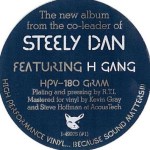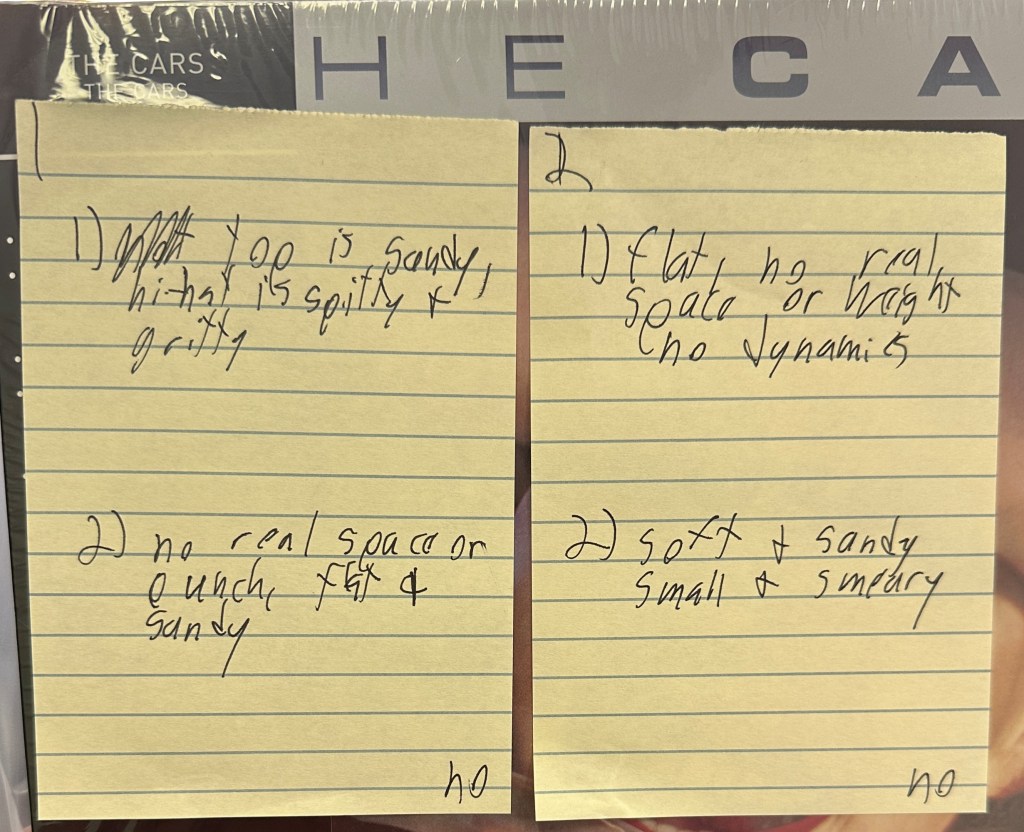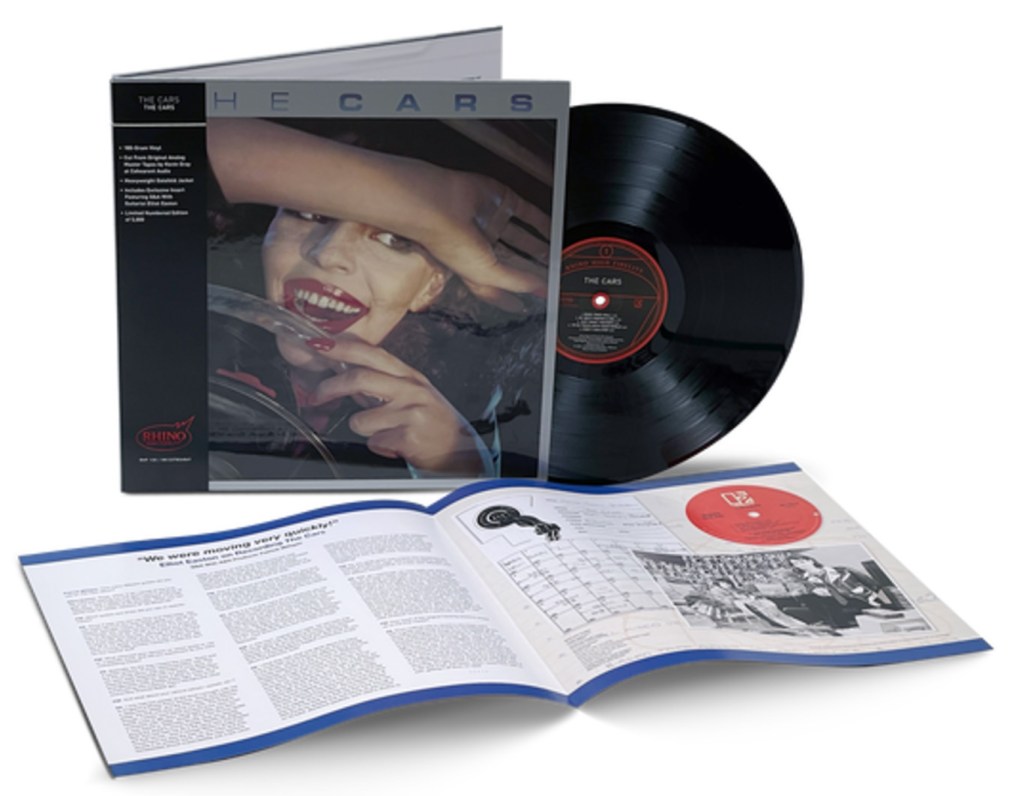
Steve Westman invited me to appear again on his youtube channel chat with the Audiophile Roundtable.
At about the 39 minute mark, we discuss my picks for what I would rate as the Five Best Sounding Records I know of.
I wanted to go with more variety, so I picked two rock records, two jazz records and one classical album.
A rough transcription with corrections and additions follows:
Before I did my top five, I wanted to say something along the lines of, if you want to know where somebody’s coming from in audio, you don’t ask them what their stereo is, you don’t ask them what their room is like, and how their electricity is done, and what their history with audio is, because they’re not going to tell you, and they just don’t want to go down that road.
But you can ask them about music, and that will tell you a lot about where they’re coming from, so here are my questions for people if I wanted to know more about their understanding of records (and, by implication, audio):
-
- One: what are the five best sounding records you’ve ever heard?
- Two: what are your five favorite records of all time?
- Three: what five famous recordings never sounded good to you?
- Four: name five recordings that are much better than most of your friends or audiophiles in general think?
In my world, you would have to tell me what pressing you’re listening to. If you said “I love the new Rhino Cars album,” I think we would be done, but if you told me that you love the original, then I would say yes, I love that record too. I bought it in 1978 and I’ve played it about 5000 times. Never gotten tired of it.
At about the 48 minute mark I reveal the best stampers for Ry Cooder’s Jazz album.
At about the 50 minute mark someone asks about my system. This would be my answer:
All that information is on the blog., I actually do a thing about my stereo where I take it all the way from 1976 to the present, which I’m sure bores people to death, but you know, there was a lot to talk about there.
There were a lot of changes that I went through and I even talk about how my old stereo from the 90s, which I had put together after having been an audiophile for 25 years, was dark and unrevealing compared to the one I have now, so all my opinions from 25 years ago are suspect, and rightly so.
I feel the same thing is going on in the world of audiophiles when you have systems that aren’t very revealing and aren’t tonally accurate, yet are very musical and enjoyable the way Geoff would like, but they’re not good for really knowing what your records sound like because your system is doing all sorts of things to the record that you’re playing in order to keep the bad stuff from bothering you.
That’s the opposite of what we have.
All the bad stuff just jumps out of the speakers, and that’s why these heavy vinyl records don’t appeal to us anymore, because we hear all the bad stuff and we don’t like it.
At 1:03 I’m asked if I like any modern mastering engineers, and the only one I can think of is Chris Bellman, because he masterered one of the few Heavy Vinyl pressing I know of that sounds any good, Brothers in Arms, released in 2021. I played it when Edgers brought it by the studio when he first visited me in preparation for his article.
My best copy was clearly better in some important ways, but Bellman’s mostly sounds right, and that surprised me because most of these modern records sound funny and weird and rarely do they sound right.
(Geoff brought over three records that day: Brothers in Arms, the remastered Zep II, and a ridiculously bad sounding Craft pressing of Lush Life, which was mastered by Kevin Gray, and one which I have not had time to review yet. It was my introduction to the Craft series, and let’s just say we got off on the wrong foot. I told Geoff it sounded like a bad CD, and that’s pretty much all I remember of it. The average price for that pressing on Discogs is roughly $69 these days. The CD is cheaper and there is very little doubt in my mind that it would be better sounding to boot.)
At 1:04 I mention the biggest snake oil salesman in the history of vinyl, the man behind The Electric Recording Company.
Patrick mentions an ERC Love record which he likes, but we played one that sounded about as bad as a bad record could sound. That Love record will never get any love from us. He says he’ll never buy another ERC pressing, but that doesn’t sound like the kind of thing someone who really likes a record would say, does it? I suppose you can ask him in the comments section why that would be.
At some point I talk about the studio we play records in, not exactly spouse-friendly but good for hearing what’s really in the grooves of the records we play:
The reason the sound room is the way it is is because you’re not there to be reading magazines and looking at your phone. You’re just in there to sit in a single chair in front of two speakers, not talking. Nobody else is in there. They have no business being in there. It’s just you and the music and that’s the way I like it.
This next section has been fleshed out quite a bit. I took the question posed and ran with it:
In Geoff Edgers’ Washington Post article about audiophiles, somebody asks “why would you want to go into a room and just play a record by yourself?”
I would answer the question with a question of my own: why would you go to a museum and just look at a painting by yourself?
You don’t need anybody around you to help you understand a painting.
You just look at the painting and that’s the experience of looking at a painting.
When I listen to a record, I want the experience of listening to the record. I don’t need anybody else around. I don’t need anybody talking to me. I just want to hear that record, and as Nathan said, I want it to take me from the beginning to the end. And at the end I should feel like I still want more.
For me, that’s what a good record and a good stereo is all about. That’s the reason some of us describe ourselves as audiophiles.
The shortest definition of an audiophile is a “lover of sound.” I love good sound and I’ve spent more than forty years building a stereo system that has what I think is very good sound. (What others think of it has never been of much concern, nor should it be.)
It’s in a dark room with no windows because music sounds better in a dark room with no windows and the door closed.
There is one chair and it is located in the only sweet spot in the room. (Yes, there can only be one sweet spot.)
I go in there to put myself in the living presence of the musicians who performed on whatever record I choose to play.
Music is loud and so I play the stereo at levels as close to live music as I can manage.
The system creates a soundfield that stretches from wall to wall and floor to ceiling. With the speakers pulled so far out into the room, they have often been known to disappear, leaving only three-dimensional imaging of great depth and precision (especially in the case of orchestral music).
By listening this way, I am able to completely immerse myself in the music I play, with no distractions of any kind.
This way of listening is more intense and powerful and transportive than any other I have known (outside of the live event of course).
That’s what I am trying to achieve with my system and the best records I can find to play on it: an experience that is so intense and powerful that I find myself completely transported out of the real world I exist in, and into the imaginary world created by the producers, engineers and musicians responsible for making the record.
If you want this kind of experience, you need more than good music. You need a good recording of that music, and, if you’re an analog sort of person with high standards, you need an exceptionally good pressing of that recording.
At the highest levels of sound quality, for us audiophiles it can’t just be about the music. You really do need all three.
Depending on your tastes and standards, good music can easily be found most everywhere. Good music with good sound, at least on vinyl, is much more rare, and good sounding music reproduced well is, in my experience, very rare indeed.
Some people are upset and put off by what they consider to be our “extreme” approach to records and audio. It bothers them that we constantly say that doing records and audio well is harder than it looks. To them it seems so easy.
Naturally, we believe there is ample evidence to support our views on the subject.
And, to paraphrase Jesus, the upset will always be with us.
I finish up with a talk about the one and only Heavy Vinyl record that has won a shootout, an Original Jazz Classic of all things, and what it would take to find another OJC title that might win the next one. The odds are not good, and the cost to find such a record would be sizable, perhaps prohibitive, but who knows? We might just get lucky again.




 It sounds like a clean, tonally correct but fairly bass-shy
It sounds like a clean, tonally correct but fairly bass-shy 


 Reviews and Commentaries for the Music of Edvard Grieg
Reviews and Commentaries for the Music of Edvard Grieg More of the Music of The Cars
More of the Music of The Cars
 If I were to try to “reverse engineer” the sound of a system that could play this record and hide its many faults, I would look for a system that was thick, dark and fat, with plenty of tube colorations and no real top end to speak of.
If I were to try to “reverse engineer” the sound of a system that could play this record and hide its many faults, I would look for a system that was thick, dark and fat, with plenty of tube colorations and no real top end to speak of.
 We Get All Kinds of Letters
We Get All Kinds of Letters